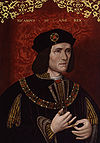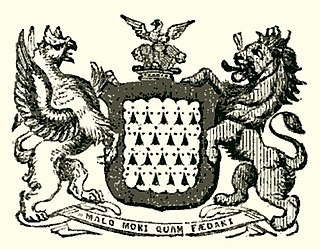Career
Early years
He is known to have been practising in the Irish courts of common law by 1477. [6] In 1478 he went to England and received a royal pardon for an unspecified offence. [1] He was appointed King's Serjeant in 1480. [7] He probably owed this appointment to the influence of Gerald FitzGerald, the "Great Earl of Kildare", who was then beginning his effective control of the Irish Government, which he dominated with short intervals for 35 years. In about 1481 Estrete was entrusted with the management of the customs duties for the Port of Drogheda. [8] In 1483 a statute of the Irish Parliament gave him first charge over any payment out of the revenues from the cocket (the official custom house seal) and customs of Dublin. [9] In 1480 a John Estrete (he is referred to as "John Estrete senior", so this was most likely the judge's father rather than the judge himself) bought land in County Meath from Simon Walshe and his wife Juliana. [5] The younger John owned a house on Fishamble Street in Dublin city centre, which he sold to Philip Fleming in 1485. [10]

Law school
As King's Serjeant, he was notable for running an elementary law school, at a time when members of the Irish Bar were required to obtain their formal education at the Inns of Court in London. Sir William Darcy, the Vice-Treasurer of Ireland for many years, recalled in later life that in 1482–83 he and other law students had spent the law terms at Estrete's house in Dublin, studying those English legal texts which were required reading for law students who intended to qualify at the Bar, and which would prepare them to proceed to the Inns of Court. Among these lawbooks was one by Estrete himself, Natura Brevium, which has not survived. [2] Estrete also taught them Law French (the official language of the law courts until the seventeenth century), and Darcy was still writing it fluently fifty years later. [11]
Under Richard III

Estrete remained in office as King's Serjeant when Edward IV was succeeded (after a short hiatus) by his brother Richard III in 1483. The King was unwilling to confirm Estrete's patron, the Earl of Kildare, as Lord Deputy of Ireland, and Kildare sent Estrete to England to plead his case to be retained as Deputy for ten years, and also demanded a salary of £1000 a year and several grants of land. Kildare also stressed the extent of his power in Ireland and the obvious advantages to the King of employing him. The King however made it clear that he would do nothing until Kildare came to see him personally, and the Earl reluctantly complied. [12] This episode probably established Estrete's role as an intermediary between Kildare and the English Crown. The King's letter of instructions to Estrete, which was to be shown to Kildare, survives. [13]







